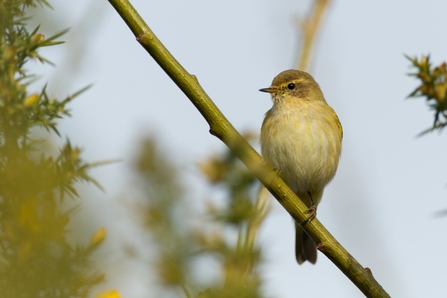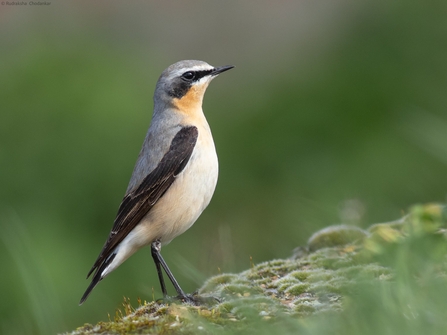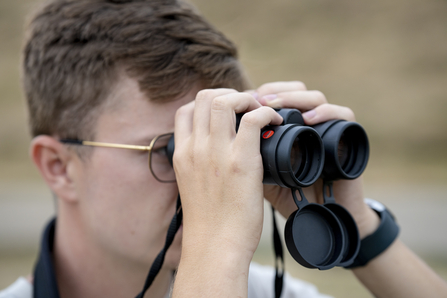Depending on what your nature interests are, the arrival of spring can mean different things. For some, it’s the first sight of the bright yellow, star-shaped flowers of lesser celandine, for others it is the jiggly gelatinous joy of frogspawn.

Chiffchaff
Photo credit: Giles Greenwood
For me, it’s the song of the chiffchaff. Colour me shocked… I am aware of the audience I am working with here.
Being one of our earliest arrivals, you can hear chiffchaffs sing their hearts out from as early as February. Their song is a simple one, spelling out their own names as if to announce themselves ‘chiff-chaff-chiff-chaff’. Hearing the first chiffchaff of the year provides the most uplifting feeling, and makes you smile, spring is here. It’s funny, it’s funny how an unassuming bird with an unassuming song can bring all this joy in just two notes.
Admittedly, two weeks later, its repetitive song can become annoying, and quite frankly you want to throttle one… (I strongly advise against this, please refer to the Wildlife and Countryside Act 1981 😉 ) but that isn't the point I am making.
Chiffchaffs, like many of our summer visitors, migrate from North Africa to breed here. A race across continents to get jiggy with it. Astonishing, given that they weigh slightly less than two teaspoons of sugar! However, in recent decades, in response to warming temperatures, many chiffchaffs now overwinter in Britain and the rest of Europe. Climate change isn’t just medalling with my personal chiffchaff spring, it can have harmful effects, as the seasons change unpredictably, it throws off the timing of flowering plants and their pollinators, nesting blues tits and the emergence of their favourite food, caterpillars. The synchrony of nature is beautiful, but climate change reminds us how finely balanced, and therefore fragile it can be.

Wheatear
Photo credit: Rudraksha Chodankar
Spring offers some of the best birding at Walthamstow Wetlands due to its position in the wider landscape. As part of the Lee Valley, it is a geographical bottleneck surrounded by increasing urbanisation. This green corridor provides migrating birds refuge to refuel as they continue their journey up through the Lee Valley and beyond. Migration is risky business and these continuous habitats are vital.
Each year, the air is thick with anticipation as visitors (and the team) wait for spring arrivals. Sand martin and wheatear are normally the first to arrive and this year was no exception.
The favourable southerly winds have led to a fantastic spring so far, with many great sightings to the delight of visitors. Check out our regular birder’s superb March sightings blog for a full round-up and what you can see around the Reserve!

Bird watching at Walthamstow Wetlands using the excellent Leica Trinovid 10 x 42s'
Photo credit: Tom Clazie Flynn
There is a lot happening at Walthamstow Wetlands to celebrate spring and the surge of bird song: why not join me on Dawn Chorus Day, and discover the amazing sounds that happen before your alarm goes off? I may even point out a chiffchaff 😉
If leaving the house before sunrise isn’t for you, we are taking part in SoundCamp, a 24+1-hour radio broadcast of the world waking up. Over the first weekend of May, hear dawn choruses live across the globe including the jangly calls of reed warbler to the backdrop hum of the city from the Wetlands very own reedbed, all in the comfort of your pyjamas.
Alternatively, if getting up early isn’t for you AT ALL, join me on a leisurely walk around the Wetlands to learn about the importance of the reserve during spring migration and for a chance to see some of our summer visitors through our superb Leica Trinovid binoculars.
Lastly, as part of our spring celebrations, pop into our visitor centre and see the latest exhibition of exquisite bird sculptures by Sandie M Sutton. Themed around local songbirds with a backdrop of common hedgerow species’ tweets and twitterings; this is an up-close and rather personal celebration of British bird life.
Spring is just great, isn't it?
Next stop, summer, screaming swifts (the best bird in the world) and bouncy tufted ducklings.

Thank you to Leica Sports Optics for supporting our activities at Walthamstow Wetlands
Instagram: leicanature
Facebook: Leica.Sport.Optics
Twitter: LeicaBirding

